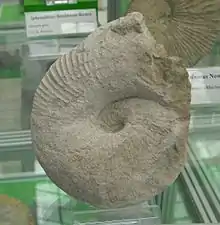Acanthoscaphites
Acanthoscaphites is an extinct genus of cephalopod belonging to the Ammonite subclass. The average diameter of its shell was approximately 20 millimetres (3⁄4 inch), but some specimens have been found with a diameter of slightly over 50 mm (2 in).
| Acanthoscaphites | |
|---|---|
 | |
| A. tridens fossil | |
| Scientific classification | |
| Kingdom: | Animalia |
| Phylum: | Mollusca |
| Class: | Cephalopoda |
| Subclass: | †Ammonoidea |
| Order: | †Ammonitida |
| Suborder: | †Ancyloceratina |
| Family: | †Scaphitidae |
| Subfamily: | †Scaphitinae |
| Genus: | †Acanthoscaphites Schluter, 1872 |
| Species | |
| |
Classification
Acanthoscaphites was first described by Schluter in 1872. Subsequent taxonomic revisions indicate that the relationship between Acanthoscaphites and Trachyscaphites is still unclear: Acanthoscaphites may have evolved in parallel with or as a derivative of Trachyscaphites.[1]
Species
- A. plenus
- A. tridens
- A. verneuilianus
Biogeography
Acanthoscaphites was a widespread genus during Campanian and Maastrichtian times, approximately 80 million years ago.[1] Its remains can be found in rocks of that age from Europe and North America.[2]
References
- Monks, Neale (2000-05-01). "Functional morphology, ecology, and evolution of the Scaphitaceae Gill, 1871 (cephalopoda)". Journal of Molluscan Studies (Volume 66, Issue 2). doi:10.1093/mollus/66.2.205.
- Dubicka, Z.; Peryt, D. (2011-01-01). "Integrated biostratigraphy of Upper Maastrichtian chalk at Chełm (SE Poland)". Annales Societatis Geologorum Poloniae (Volume Vol. 81, No 2).
This article is issued from Wikipedia. The text is licensed under Creative Commons - Attribution - Sharealike. Additional terms may apply for the media files.